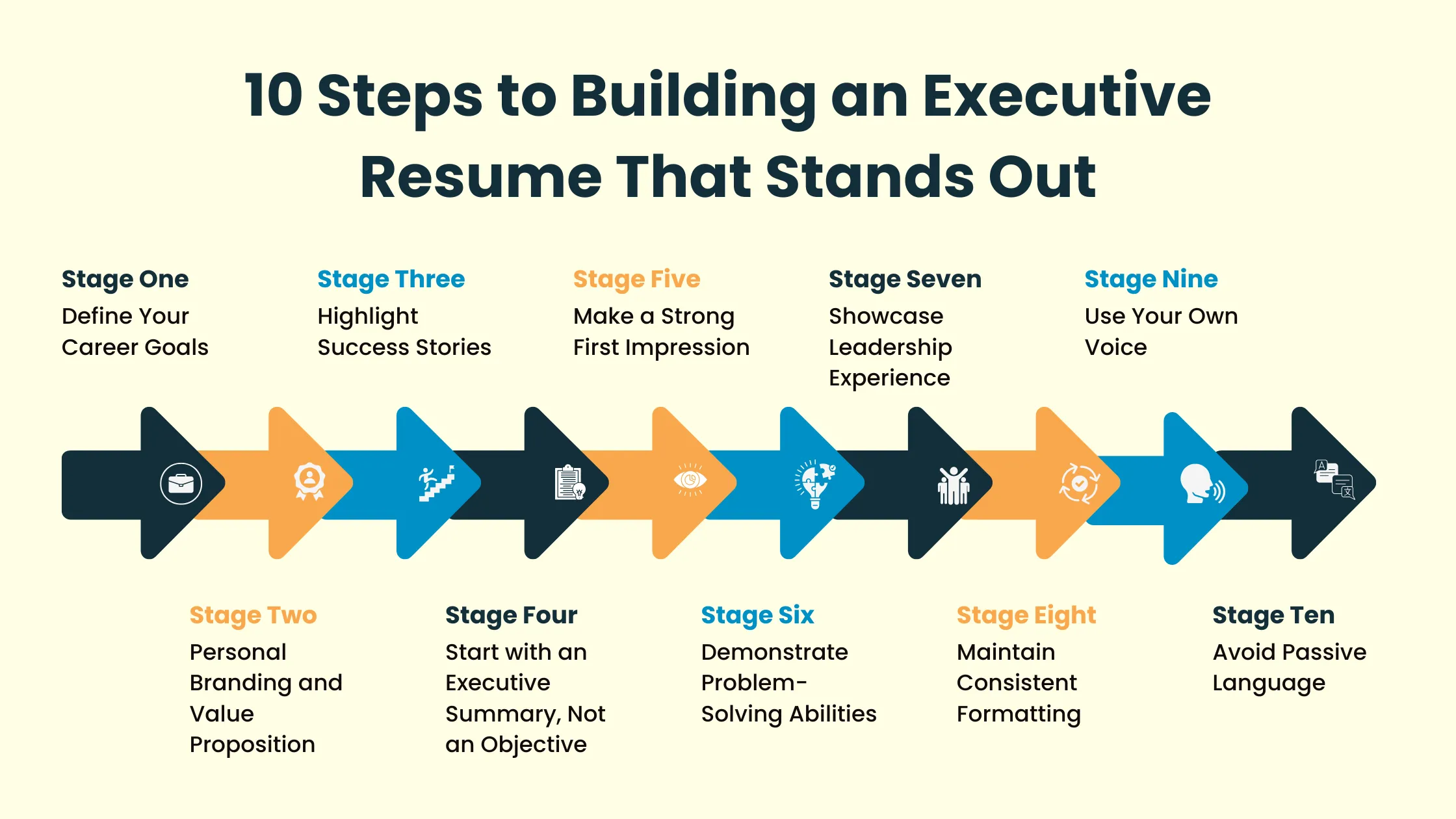TL;DR
- Craft an executive resume that highlights leadership, measurable success, and aligns with company values.
- Use a strong executive summary instead of an objective to capture attention quickly.
- Follow a 10-step strategy including personal branding, problem-solving, and consistent formatting.
- Tailor your resume for each executive role and use active, impactful language.
In today’s fiercely competitive executive job market, your resume is more than a chronological account of roles; it’s your personal brand statement. At the senior level, hiring decisions are often influenced by reputation, networking, and strategic fit rather than job board applications. A well-crafted executive resume not only communicates your capabilities but positions you as a leader aligned with an organisation’s vision.
So, how do you ensure your executive resume stands out amidst a sea of accomplished professionals? This guide provides a refined 10-step strategy for creating a resume that showcases leadership, measurable achievements, and professional polish.
What Makes an Executive Resume Stand Out?
Only a good executive resume will exhibit leadership alongside measurable attainment against industry-specific keywords. Open with a strong executive summary followed immediately by focusing on aligning one's values with the organisation. Use a very polished, professional format to make it carefully easy to read and to leave a positive impression. So, how do you make an executive resume that stands out and gets noticed?
This executive search resume guide will help you create a resume that highlights your skills, communicates your worth, and leaves a strong impression using a 10-step resume-making approach.
1. Define Your Career Goals
First, make sure you know exactly which companies and job roles you want to apply for. Learn about each company and show how your skills match what they need. This means sending your executive resume in a way that shows you’re serious about working there.
If you stand for everything, you stand for nothing. Be clear about what you want so you can find the right job offers.
2. Personal Branding and Value Proposition
Your executive resume should clearly show your personal brand. Consider how you want to present yourself to potential employers and clearly explain what you can offer. A strong brand highlights your unique strengths and aligns with the company's objectives and culture.
3. Highlight Success Stories
Highlighting your successes is crucial for a strong executive resume. Detail your career accomplishments, especially those that led to profitable growth or goal completion. Use the PAR (Problem-Action-Result) method to organise these stories, demonstrating what you achieved and its impact.
4. Start with an Executive Summary, Not an Objective
Old-fashioned objective statements talk about what you want from the job. Instead, write an executive summary that highlights your best accomplishments and shows how you can help the company. This introduction should be brief but strong, explaining who you are and why you’re the perfect fit for the job.
5. Make a Strong First Impression
Employers usually look at each executive resume for just a few seconds, so your resume’s layout should grab their attention right away. Use smart design elements to make important parts of your resume stand out, helping the reader focus on the most important details about you.
6. Demonstrate Problem-Solving Abilities
Provide examples of times you recognised problems and found successful solutions. Point out situations where you made processes better, solved disagreements, or handled difficult situations. Focus on your ability to think strategically and adapt, showing how your problem-solving skills led to clear improvements or saved resources.
7. Showcase Leadership Experience
Also, highlight roles where you led teams, made important decisions and achieved significant results. Mention specific accomplishments, like managing budgets, working with different teams, or leading successful projects. Show that you can motivate others, have influence, and achieve outcomes that match the goals of the organisation.
8. Maintain Consistent Formatting
Consistent formatting improves readability. Select a professional font and colour scheme, and use them consistently. Avoid overusing bold or italics, and keep the structure of each job or role section the same. A neat layout helps recruiters quickly find important information.
9. Use Your Own Voice
Many resumes fail because they use too much generic language. Instead, write your executive resume in a way that shows your personality and professional style. This can help you stand out from others with similar qualifications.
10. Avoid Passive Language
Don’t use weak or passive verbs like “responsible for” or “led a team of.” Instead, use strong action verbs that show what you did, like “drove,” “spearheaded,” or “increased.” These words help show what you can do and what you’ve achieved.
Conclusion
Creating a strong executive resume is more than just listing your job titles and duties. By following these 10 steps, you’ll make a resume that tells a powerful story about your career.
Keep in mind your resume is your first impression. Make sure it’s aimed at the right companies, highlights what makes you special, and looks professional and free of mistakes.
If you need more help or are having trouble with this, think about getting advice from a professional service. Your dream job could be just a resume away, get ahead in recruitment with our Executive Search Knowledge Hub.
Frequently Asked Questions (FAQs)
1. What is the difference between an executive resume and a standard resume?
A standard resume usually lists your responsibilities and job history, but an executive resume goes a step further. It highlights the bigger picture of your leadership, strategic thinking, and the tangible impact you’ve made. It’s about showing what you’ve delivered at a senior level, not just what you’ve done.
2. How long should an executive resume be?
Two to three pages are usually spot-on. You likely have a lot of experience under your belt, but it still needs to be relevant and easy to understand. Think of it as a curated overview rather than a comprehensive career diary.
3. Do I need to tailor my resume for every executive role?
Yes. Especially at the executive level. Each company is looking for a specific type of leader, and your resume should reflect how you align with that. Adjust your summary, key achievements, and language to align with what they’re looking for. It makes a big difference.
4. What common mistakes should I avoid in an executive resume?
Avoid vague wording, passive phrases, and inconsistent formatting. Instead of simply listing your responsibilities, focus on the results you’ve delivered and how you’ve made an impact as a leader.















